Abstract
Fat-cells were isolated from patients of body-mass indices (BMIs) ranging from 17.9 to 83.9 kg/m2. Isoprenaline-stimulated cyclic AMP accumulation in cells prepared from obese subjects as compared with normal-weight subjects, was less sensitive to inhibition by the adenosine agonist N6-(phenylisopropyl)adenosine (PIA) (P = 0.047). The inhibition of 7 beta-desacetyl-7 beta-[gamma-(N-methylpiperazino) butyryl]-forskolin-stimulated adenylate cyclase by PIA in the presence of adenosine deaminase was also much attenuated in crude plasma membranes of adipocytes prepared from massively obese patients as compared with lean controls (P = 0.0143). This difference was probably not due to different cell size, because adenylate cyclase of crude plasma membranes of large adipocytes was actually more sensitive to PIA than was adenylate cyclase of membranes of smaller fat-cells co-isolated from the same individual. The stimulatory effect of PIA on glucose uptake in the presence of adenosine deaminase was depressed in adipocytes prepared from obese subjects and correlated with BMI at r = -0.626 (P = 0.007) at 100 nM-PIA. The adenosine receptors were studied by using the adenosine antagonist 1,3-[3H]dipropyl-8-cyclopentylxanthine. The binding was rapid and proportional to protein concentration. There was no difference in the affinities of receptors in membranes of obese and normal-weight subjects; Kd values of all patients averaged 3.3 nM. Bmax values were 54 and 130 fmol/mg of protein in membranes prepared from seven obese and five control patients respectively. The Bmax values calculated per mg of protein correlated with BMI at r = -0.539 (P = 0.047). The adenosine content of adipose tissue was higher in obese than in control subjects. These results demonstrate an attenuated response of cyclic AMP accumulation, adenylate cyclase and glucose uptake to adenosine in fat-cells prepared from obese subjects, and suggest that this change is at least partly due to changes in the amount of adenosine receptors, but not their affinity. The decreased receptor number could be due to higher adenosine content. A higher adenosine concentration in adipose tissue could explain why lipolysis is inhibited in situ in obesity, and the desensitization could explain the diminished response to adenosine analogues in isolated fat-cells.
Full text
PDF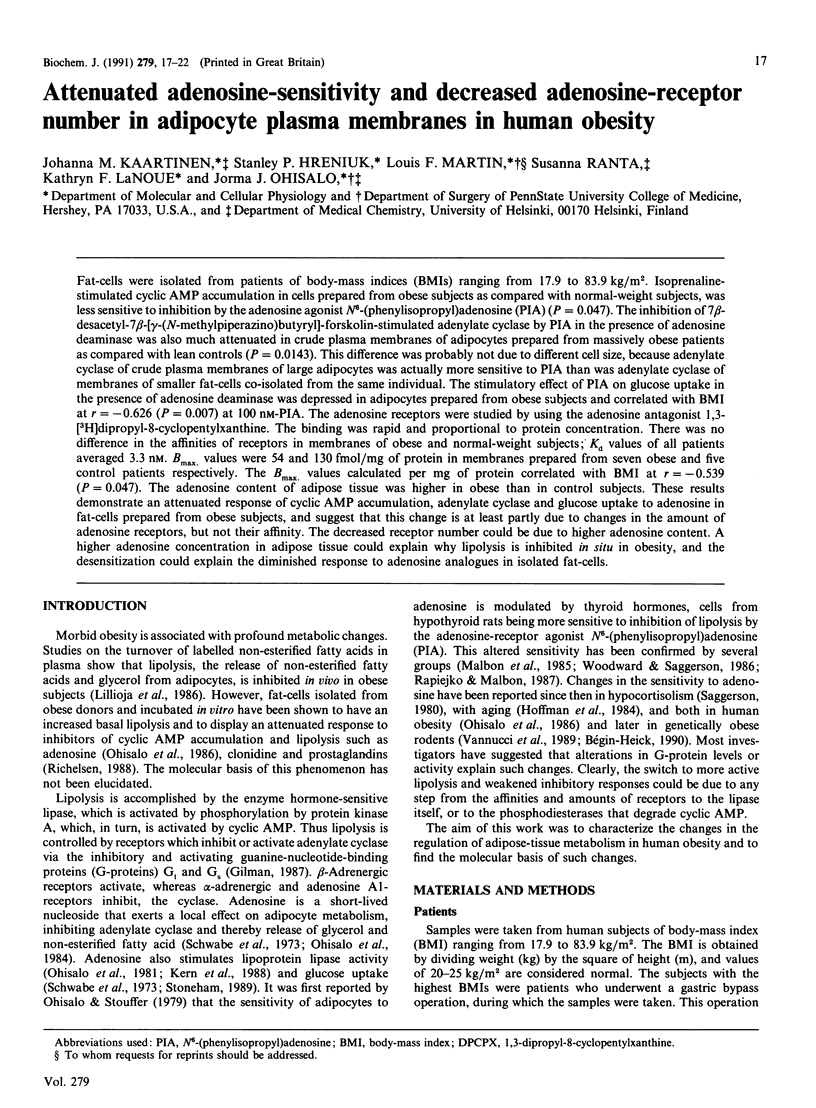
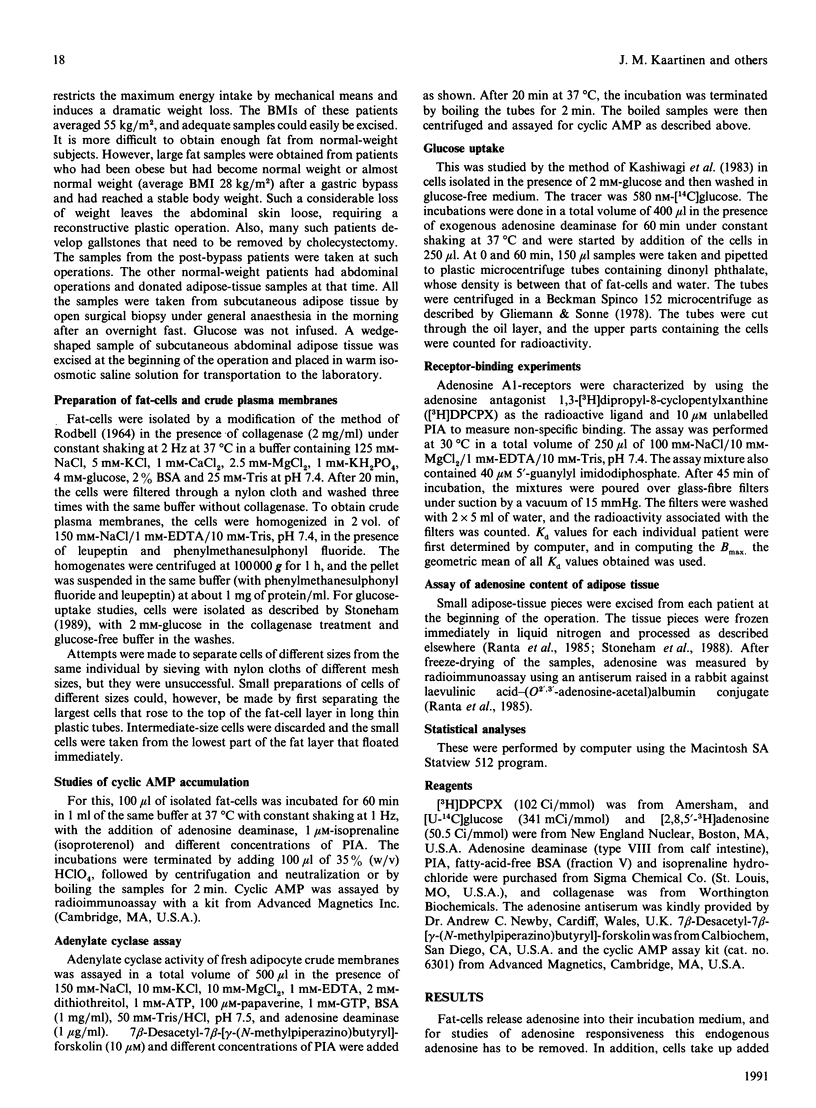
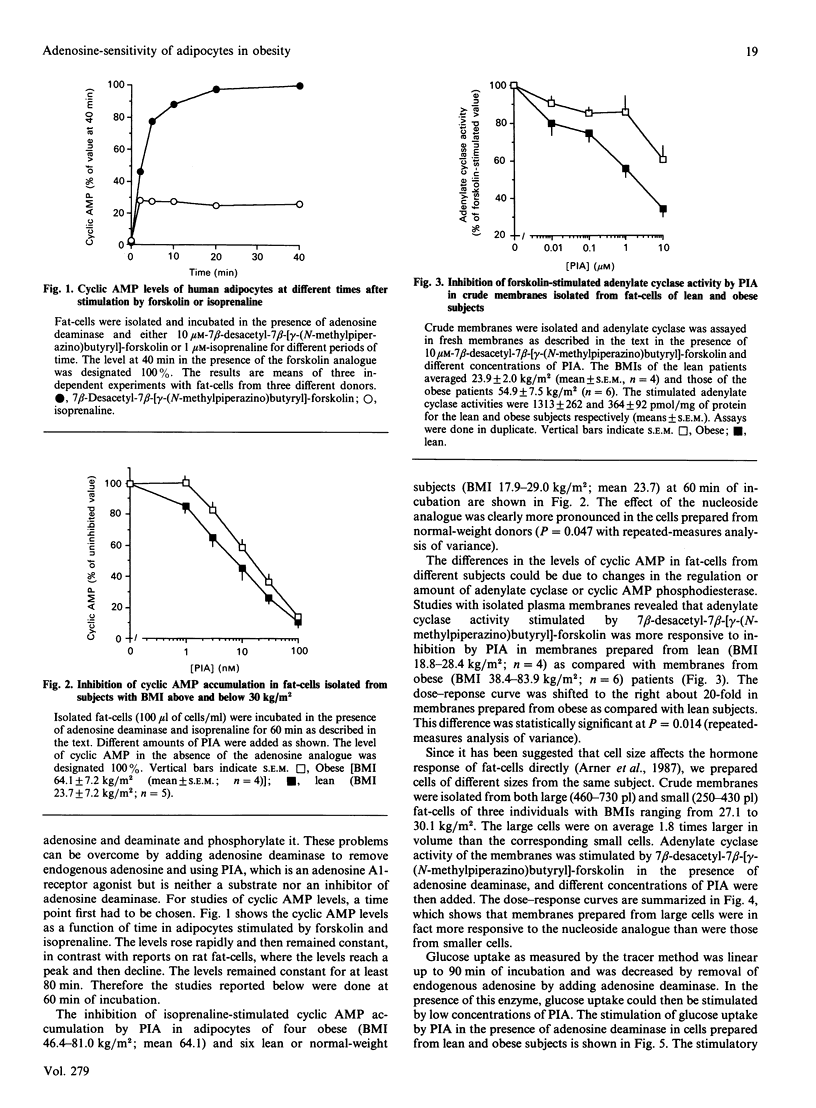
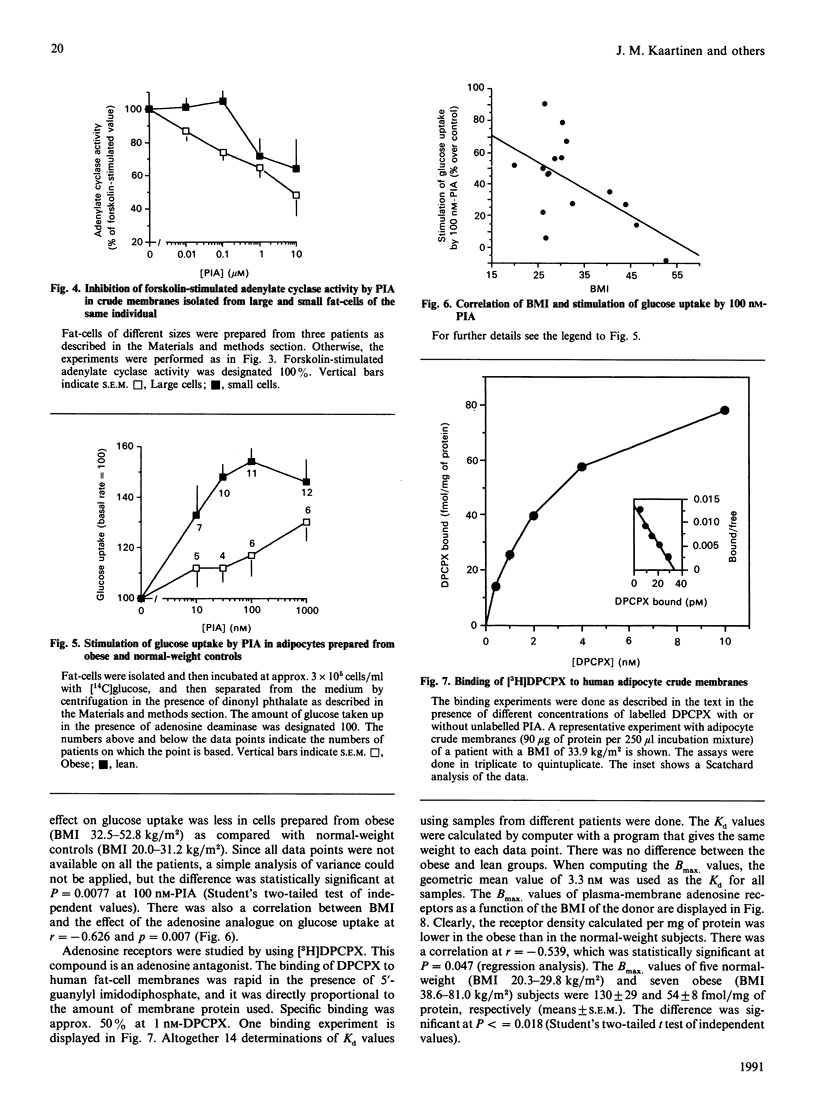
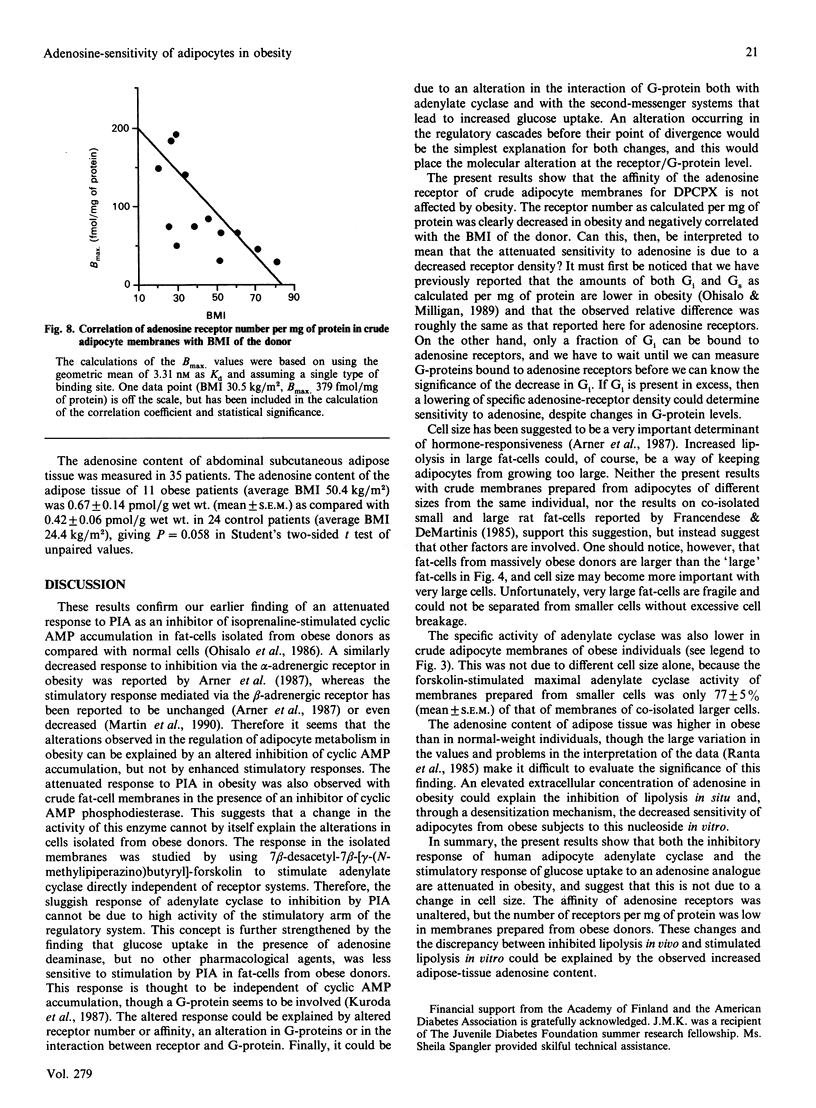

Selected References
These references are in PubMed. This may not be the complete list of references from this article.
- Arner P., Marcus C., Karpe B., Sonnenfeld T., Blome P. Role of alpha-adrenoceptors for adipocyte size in man. Eur J Clin Invest. 1987 Feb;17(1):58–62. doi: 10.1111/j.1365-2362.1987.tb01226.x. [DOI] [PubMed] [Google Scholar]
- Bégin-Heick N. Quantification of the alpha and beta subunits of the transducing elements (Gs and Gi) of adenylate cyclase in adipocyte membranes from lean and obese (ob/ob) mice. Biochem J. 1990 May 15;268(1):83–89. doi: 10.1042/bj2680083. [DOI] [PMC free article] [PubMed] [Google Scholar]
- Francendese A., DeMartinis F. D. Very small fat cells. II. Initial observations on basal and hormone-stimulated metabolism. J Lipid Res. 1985 Feb;26(2):149–157. [PubMed] [Google Scholar]
- Gilman A. G. G proteins: transducers of receptor-generated signals. Annu Rev Biochem. 1987;56:615–649. doi: 10.1146/annurev.bi.56.070187.003151. [DOI] [PubMed] [Google Scholar]
- Gliemann J., Sonne O. Binding and receptor-mediated degradation of insulin in adipocytes. J Biol Chem. 1978 Nov 10;253(21):7857–7863. [PubMed] [Google Scholar]
- Hoffman B. B., Chang H., Farahbakhsh Z., Reaven G. Inhibition of lipolysis by adenosine is potentiated with age. J Clin Invest. 1984 Nov;74(5):1750–1755. doi: 10.1172/JCI111593. [DOI] [PMC free article] [PubMed] [Google Scholar]
- Kashiwagi A., Verso M. A., Andrews J., Vasquez B., Reaven G., Foley J. E. In vitro insulin resistance of human adipocytes isolated from subjects with noninsulin-dependent diabetes mellitus. J Clin Invest. 1983 Oct;72(4):1246–1254. doi: 10.1172/JCI111080. [DOI] [PMC free article] [PubMed] [Google Scholar]
- Kern P. A., Ong J. M., Goers J. W., Pedersen M. E. Regulation of lipoprotein lipase immunoreactive mass in isolated human adipocytes. J Clin Invest. 1988 Feb;81(2):398–406. doi: 10.1172/JCI113332. [DOI] [PMC free article] [PubMed] [Google Scholar]
- Kuroda M., Honnor R. C., Cushman S. W., Londos C., Simpson I. A. Regulation of insulin-stimulated glucose transport in the isolated rat adipocyte. cAMP-independent effects of lipolytic and antilipolytic agents. J Biol Chem. 1987 Jan 5;262(1):245–253. [PubMed] [Google Scholar]
- Lillioja S., Foley J., Bogardus C., Mott D., Howard B. V. Free fatty acid metabolism and obesity in man: in vivo in vitro comparisons. Metabolism. 1986 Jun;35(6):505–514. doi: 10.1016/0026-0495(86)90006-5. [DOI] [PubMed] [Google Scholar]
- Malbon C. C., Rapiejko P. J., Mangano T. J. Fat cell adenylate cyclase system. Enhanced inhibition by adenosine and GTP in the hypothyroid rat. J Biol Chem. 1985 Feb 25;260(4):2558–2564. [PubMed] [Google Scholar]
- Martin L. F., Klim C. M., Vannucci S. J., Dixon L. B., Landis J. R., LaNoue K. F. Alterations in adipocyte adenylate cyclase activity in morbidly obese and formerly morbidly obese humans. Surgery. 1990 Aug;108(2):228–235. [PubMed] [Google Scholar]
- Ohisalo J. J., Milligan G. Guanine-nucleotide-binding proteins Gi and Gs in fat-cells from normal, hypothyroid and obese human subjects. Biochem J. 1989 Jun 15;260(3):843–847. doi: 10.1042/bj2600843. [DOI] [PMC free article] [PubMed] [Google Scholar]
- Ohisalo J. J., Ranta S., Huhtaniemi I. T. Attenuated adenosine R-site effect in adipocytes in obesity. Metabolism. 1986 Feb;35(2):143–146. doi: 10.1016/0026-0495(86)90115-0. [DOI] [PubMed] [Google Scholar]
- Ohisalo J. J., Ranta S., Huhtaniemi I. T. Inhibition of adenosine 3',5'-monophosphate accumulation and lipolysis by adenosine analogs in human subcutaneous adipocytes. J Clin Endocrinol Metab. 1984 Jan;58(1):32–35. doi: 10.1210/jcem-58-1-32. [DOI] [PubMed] [Google Scholar]
- Ohisalo J. J., Stouffer J. E. Adenosine, thyroid status and regulation of lipolysis. Biochem J. 1979 Jan 15;178(1):249–251. doi: 10.1042/bj1780249. [DOI] [PMC free article] [PubMed] [Google Scholar]
- Ohisalo J. J., Strandberg H., Kostiainen E., Kuusi T., Ehnholm C. Stimulation of lipoprotein lipase activity of rat adipose tissue and post-heparin plasma by N6-(phenylisopropyl)adenosine. FEBS Lett. 1981 Sep 14;132(1):121–123. doi: 10.1016/0014-5793(81)80442-5. [DOI] [PubMed] [Google Scholar]
- RODBELL M. METABOLISM OF ISOLATED FAT CELLS. I. EFFECTS OF HORMONES ON GLUCOSE METABOLISM AND LIPOLYSIS. J Biol Chem. 1964 Feb;239:375–380. [PubMed] [Google Scholar]
- Ranta S., Kiviluoto T., Newby A. C., Ohisalo J. J. Assay of adenosine in human adipose tissue. Acta Endocrinol (Copenh) 1985 Nov;110(3):429–432. doi: 10.1530/acta.0.1100429. [DOI] [PubMed] [Google Scholar]
- Rapiejko P. J., Malbon C. C. Short-term hyperthyroidism modulates adenosine receptors and catalytic activity of adenylate cyclase in adipocytes. Biochem J. 1987 Feb 1;241(3):765–771. doi: 10.1042/bj2410765. [DOI] [PMC free article] [PubMed] [Google Scholar]
- Richelsen B. Prostaglandin E2 action and binding in human adipocytes: effects of sex, age, and obesity. Metabolism. 1988 Mar;37(3):268–275. doi: 10.1016/0026-0495(88)90107-2. [DOI] [PubMed] [Google Scholar]
- Saggerson E. D. Increased antilipolytic effect of the adenosine 'R-site' agonist N6-(phenylisopropyl)adenosine in adipocytes from adrenalectomized rats. FEBS Lett. 1980 Jun 16;115(1):127–128. doi: 10.1016/0014-5793(80)80741-1. [DOI] [PubMed] [Google Scholar]
- Schwabe U., Schönhöfer P. S., Ebert R. Facilitation by adenosine of the action of insulin on the accumulation of adenosine 3':5'-monophosphate, lipolysis, and glucose oxidation in isolated fat cells. Eur J Biochem. 1974 Aug 1;46(3):537–545. doi: 10.1111/j.1432-1033.1974.tb03647.x. [DOI] [PubMed] [Google Scholar]
- Stoneham S., Kiviluoto T., Keso L., Ohisalo J. J. Adenosine and the regional differences in adipose tissue metabolism in women. Acta Endocrinol (Copenh) 1988 Jul;118(3):327–331. doi: 10.1530/acta.0.1180327. [DOI] [PubMed] [Google Scholar]
- Stoneham S. Rat adipose tissue adenosine sensitivity and adenosine content after subcutaneous administration of N6-(phenylisopropyl)adenosine. Acta Endocrinol (Copenh) 1989 Mar;120(3):351–356. doi: 10.1530/acta.0.1200351. [DOI] [PubMed] [Google Scholar]
- Vannucci S. J., Klim C. M., Martin L. F., LaNoue K. F. A1-adenosine receptor-mediated inhibition of adipocyte adenylate cyclase and lipolysis in Zucker rats. Am J Physiol. 1989 Dec;257(6 Pt 1):E871–E878. doi: 10.1152/ajpendo.1989.257.6.E871. [DOI] [PubMed] [Google Scholar]
- Woodward J. A., Saggerson E. D. Effect of adenosine deaminase, N6-phenylisopropyladenosine and hypothyroidism on the responsiveness of rat brown adipocytes to noradrenaline. Biochem J. 1986 Sep 1;238(2):395–403. doi: 10.1042/bj2380395. [DOI] [PMC free article] [PubMed] [Google Scholar]


